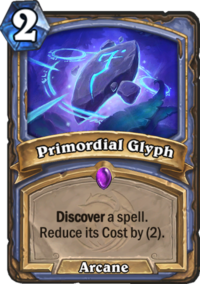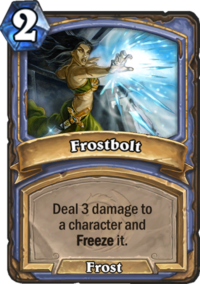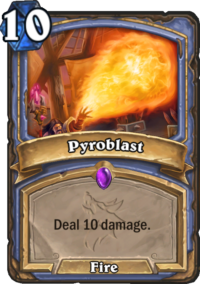Primordial Glyph has been one of the most controversial cards since its introduction in Journey to Un’Goro. Currently, it is played in most Mage decks, in both Standard and Wild formats. It is able to generate cards that can be used in both the early stages of the game, as well as the late stages. With Primordial Glyph, your dreams of having more than 2 copies of Ice Block or 8-Mana Pyroblast can finally become a reality! In this article, we are going to analyze the possible outcomes of Primordial Glyph and how to interpret the card pick from Primordial Glyph and play around it in Standard format.
Mage Spells

Currently, there are 31 Mage spells that can be created by Primordial Glyph in Standard (one of them being the card itself). The probability to discover a specific card off of Primordial Glyph is approximately 9.7%, including Primordial Glyph. Even though guessing the impact of every spell for every game state is impossible, we can still estimate the general tendencies of the players while choosing a spell according to the matchup. In addition, we are going to try to understand the cards in the opponent’s hand according to his/her plays involving Primordial Glyph. In this article I will assume the Mage player is playing a Control Mage list since it has been the most persistent deck for the class.
Let’s start with the overall evaluation of the cards which can be found in the table below. For the general case, high priority means the card has a great potential to turn the game around and/or a high power level, medium priority means situationally good spells and low priority means the spell has an impact on the game under certain circumstances. It should be noted that; the evaluations presented in this article are roughly estimated and in a general sense based on my personal preferences since, in order to estimate the impact of every single card it is necessary to have a significant amount of game play data yet it is still disputable with that much data. However, we can use this framework to estimate the outcomes of Primordial Glyph.
Overall Priority
The above table represents the overall priority of each spell in the game in general. As we can see in the table above, out of 30 spells, 12 of them are high priority, 10 of them are medium- priority and the remaining 8 spells are low priority. In other words; only around 3.7% of the time players will see all low-priority card options presented to them when they play Primordial Glyph. This indicates that; generally, the outcome of Primordial Glyph would be a spell with medium to high priority.
Based on the table above, the counts and probabilities to discover a certain type of effect can be found below.
| Type | Count | Probability |
|---|---|---|
| AOE (4+) | 1 | 9.68% |
| AOE (2+) | 3 | 29.03% |
| Freeze all | 2 | 19.35% |
| Freeze (1+) | 3 | 29.03% |
| Freeze (1) | 4 | 38.71% |
| Secret (minion) | 2 | 19.35% |
| Secret (spell) | 3 | 29.03% |
| Secret (attack) | 2 | 19.35% |
| Burn (3+) | 4 | 38.71% |
| Burn (6+) | 2 | 19.35% |
| Single target (8+) | 4 | 38.71% |
| Single target (6+) | 5 | 48.39% |
Notes
- (X+): X or more damage. In case of freeze, number of targets that can be frozen with the spell.
- Secret (trigger): The triggering condition of the secret. Spellbender is included under “(spell)”.
- Burn: Spells that can deal face damage.
- Single Target: Targets a single minion. Meteor is evaluated under this category instead of AOE.
- Primordial Glyph is not included in any category, but included in the probability calculations.
The above table tells us that there is a relatively high probability to discover a single target removal, for the case of 6+ around 48%. However, for AOE, there is a 29% probability to discover a spell that can deal 2 or more damage to minions. From a probability point of view, if your opponent has a spell created by Primordial Glyph it is much more likely to be a single target removal than AOE.
The Trick
The important part of playing against Primordial Glyph is when your opponent discovers a spell but does not play it. Below, I will explain how to extract information depending on the game state if your opponent does not play the discovered spell immediately.
“Turn 2” Primordial Glyph
In the Journey to Un’Goro Meta game there are many aggressive decks with early threats that should be dealt with immediately such as Vicious Fledgling, Murloc Tidecaller, Mana Wyrm etc. The damage needed is generally 3, which is the magic number of the early game in the current meta, and in some cases 2 therefore the first spell that comes to mind is Frostbolt. For a Burn Mage it is generally the case to play Frostbolt on turn two, which is an auto-keep against most of the decks in the meta. In case of the absence of Frostbolt, Primordial Glyph may give an immediate answer or a possible answer on the following turn when facing against Vicious Fledgling (i.e. Fireball if the adaptation is +1/+1).
Example
Consider the following state in a game of Control Mage vs Midrange Murloc Paladin:

- Turn 1 Mage (Going First): Pass
- Turn 1 Paladin (Going second): Murloc Tidecaller
- Turn 2 Mage: Primordial Glyph
- Under these circumstances we can conclude;
- 1-Mage does not have Frostbolt.
- 2-Mage did not discover Frostbolt or Flame Geyser.
- 3-Mage is unlikely to have Arcanologist or chose not to play it because they have volcanic potion on turn 3.
- Let’s continue with the game.
- Turn 2 Paladin: Rockpool Hunter, +1/+1 to Murloc Tidecaller (now 3/3)
- Turn 3 Mage: Arcane Intellect
Now We Can Conclude
- Mage is unlikely to have discovered Volcanic Potion. If discovered but chose not to play it, Mage probably does not have Bloodmage Thalnos.
- Mage is unlikely to have discovered a secret. If a secret was discovered, Mage does not have Medivh's Valet in hand.
- The cards to play around turn 4 Meteor, Blizzard and turn 5 Flamestrike. Therefore if Paladin is going to play Murloc Warleader turn 3, on turn 4 the follow up should be either Blessing of Kings or Gentle Megasaur looking for health or divine shield (even deathrattle is fine).
“Turn 4” Primordial Glyph
Another common turn to play Primordial Glyph is turn 4 since there are many 2 mana plays in the deck such as Arcanologist, Medivh's Valet (especially if there is a secret), Fireblast etc. During the mid-game, the discover decision is affected by the game state.
If Mage is ahead, especially with board presence, the variety of the spells increases since there are many reasonable picks among the spells that can be discovered such as, burn (Fireball, Firelands Portal), secret for tempo or value cards to not run out of cards.
If the board is empty with high health totals on both sides (which is generally the case in the mirror after exchanging Frostbolts, Mana Wyrms etc.), Firelands Portal would be the best pick to create board presence on the following turn and possibly kill a minion in the process. Value spells (especially Cabalist's Tome) would be an option in the mirror if Mage has late game cards in hand such as Alexstrasza and/or Medivh, the Guardian or is light on cards. Against aggro or midrange, specific answers would be picked such as Polymorph against Tirion Fordring and Spikeridged Steed, Meteor or Polymorph for Bittertide Hydra, 2+ AOE against Living Mana etc.
If Mage is behind, the cards to look for are generally AOE or Ice Block (Ice Barrier may work against aggro). In this case it should be easier to play around the card off of Glyph since the game state would clearly indicate how Mage could turn the game around.
Even though it is hard to read what the discovered card is in most cases, you can still extract information by asking the right questions and avoiding disaster at the same time. As an example, given an empty board, it is better to play Bittertide Hydra instead of Living Mana since there are 2 cards that can deal with it (Meteor, Polymorph), on the other hand against Living Mana there’s Volcanic Potion, Blizzard, Flamestrike and even Arcane Explosion with Bloodmage Thalnos. Therefore it is better to ask for Meteor first and if they have it, Living Mana can be played the turn after. If they don’t, Living Mana should be played together with Innervate, Mark of the Lotus/Power of the Wild to play around Volcanic Potion/Blizzard.
When the card discovered from a midgame Primordial Glyph is played, it gives some information about the rest of their hand. As an example if the Mage player plays a 2-mana Fireball on turn 6 targeting one of many minions on the board, that means he/she is trying to catch up rather than trying to finish the game. In this case, it is still better to play around AOE, however, the Mage is more likely to make the trades for you, therefore it may be better to push for damage (while playing around AOE) rather than kill off their minions with the purpose of staying out of burn range.
Late Game
In the late game, generally the card will be played immediately and typically there are either cards that answer a certain threat on the board (Polymorph for Tirion or Flamestrike to a huge board), burn to close out the game, or Ice Block to live for another turn. There is no difference of a top decked Flamestrike or Polymorph except that the Mage would still have a copy of it in their deck, if they haven’t played it already. In addition, in the late game, the way the game will end is more clear therefore, the choices are generally obvious, and it is less likely they choose the worse card. However, there are some tips to consider when there are 3-4 turns until the game is over.

Control Mage generally ends the game in two ways: big board through Medivh with some burn or Alexstrasza into 15 points of burn. In case of a big board, if you can deal with it or win the game right away, you are unlikely to lose the game anyway. However, if you can deal with the minions that come from Atiesh and Medivh himself (taking some damage in the process), then the only way for the Mage to win is to burn you out. The magic number for both cases is 18, 2x Fireball (or a combination of Frostbolts and Valets) and 1x 2-mana Fireball. If they have played a copy of Fireball but they have 2 spells created by Primordial Glyph, then the magic number is 16; 2-mana Fireball and 8-mana Pyroblast or 10-mana Pyroblast and 2x 0-mana Frostbolts. There is also the unlikely cases of 21 (2x 2-mana Fireball, 4-mana Fireball , Bloodmage Thalnos or Frostbolt/Valet) however, if the Mage has two 2-mana Fireballs in their hand, the game was probably not even close. Therefore, in the late game, extra care should be taken with your health total and tracking of how much burn is left in their deck, combined with potential burn off of Primordial Glyph, is of utmost importance.
In the late game, if Mage has a spell created by Primordial Glyph played in the early or midgame, make sure you have asked for every single type of card. If so, most likely, the card is some sort of a burn like Pyroblast or Ice Block which they cannot play if they already have one. This matter is very important especially in the mirror since Ice Block is a more than reasonable choice off of a Primordial Glyph played on turn 3-4-5 to increase the number of turns for burn and Ice Block. In addition, some plays give hints regarding their hand such as pinging face instead of a 1-health minion or not trading with their 2-power minion and going face would indicate that they are about to burn you out, therefore, it is important to keep your life total as high as possible.
Primordial Glyph is a matter of discussion in the community and the general issue is the discount of the spell discovered. The discount makes possible plays such as turn 4 Blizzard/Meteor or turn 5 Flamestrike/Firelands Portal, which changes how one should play against Mage. The card increases the consistency of Mage decks in terms of being able to respond to threats and/or to close out the games which makes Primordial Glyph a powerhouse card and a staple of the Journey to Un’Goro expansion. Even though the cards’s effect is based in RNG, the limited pool and the decision making process is important to understand to which card the Mage player would lean into. Giving more thought to what the Mage player was looking for, what would be their second choice or any situational card would provide more information regarding the game against a Mage player.

Excellent analysis — as a consistent mage player, it was interesting to see your insight into how I select spells.
Good analysis.
The card is busted and is an auto 2x in every mage deck in every format. It was a mistake.
Similar cards have been made in other games with the mana reduction and were banned.
The only reason this isn’t nerfed is because mage as a whole is very good, but isn’t oppressive.
They do nerf it with bad spells in new expansions, making this card less consistent
New spells are infact not that powerful, overall below average I think. Similacrum could be a good pick if Secret Mage countinues to exist (to copy crystal runner or arcane giant even valet would be fine). If Mage is in top tier after the release, which I think will be tier 2, I would update the article according to the new spells.